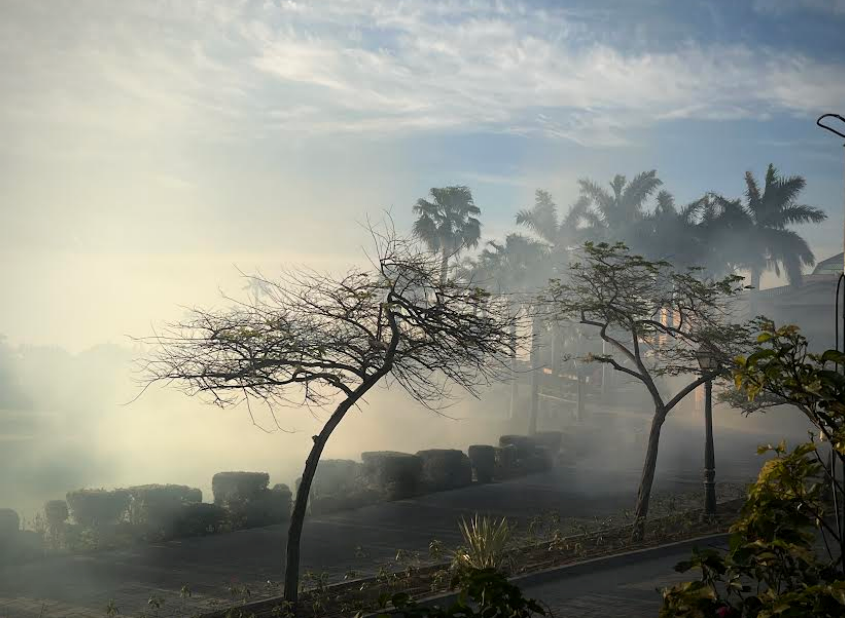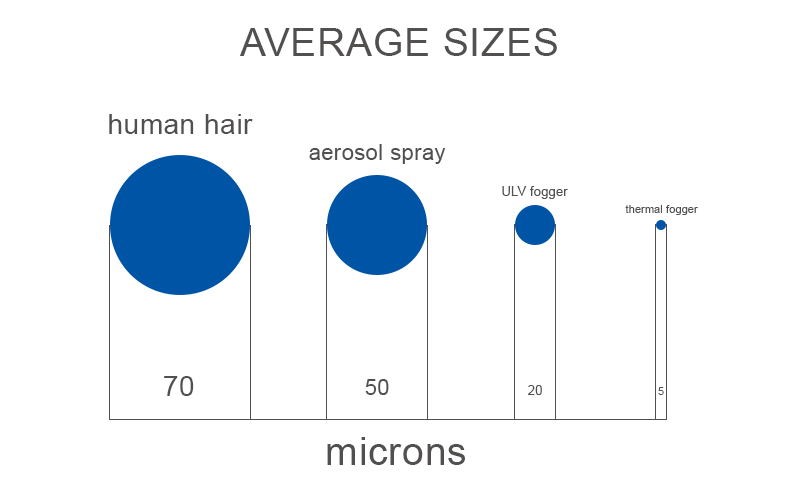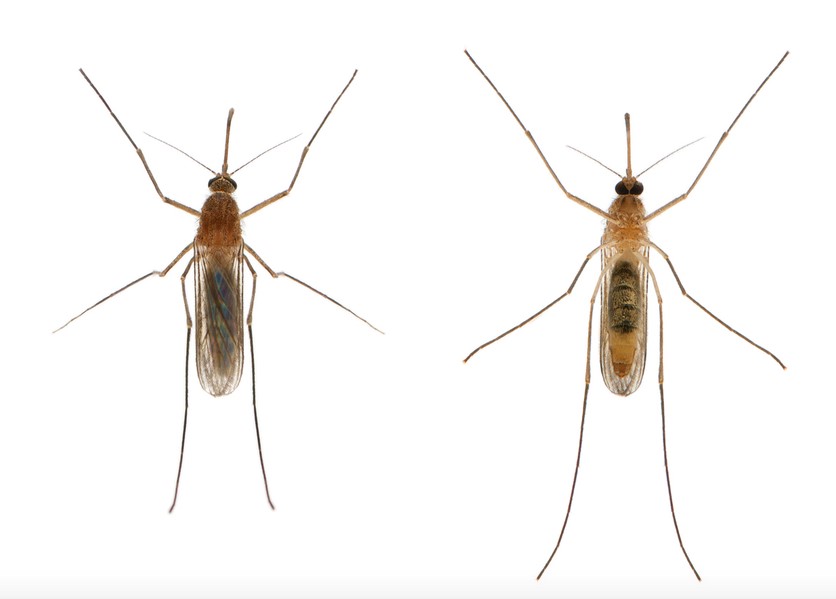Summer is almost upon us and with the heat, mosquito and fly populations will inevitably flourish. It is around this time of year that the fogging trucks circle around Cairo’s residential compounds and seaside gated communities, billowing thick clouds of fog at dawn and dusk. Soon, familiar and sometimes heated debates amongst compound residents will begin over what is more detrimental to residents – pesticidal fog or pestilent mosquitoes.
Is mosquito fogging harmful to humans and the environment?
The short answer is that, if properly administered, mosquito fogging should be harmful to neither people nor pets and its effect on the environment should be minimal, though it will never be entirely absent. The operative word though is “if”.
Before analyzing all variables of fogging and their impacts on both safety and efficacy, a few words are necessary regarding Pest and Vector Control Operators, as they are the first link in a long chain of variables.
Pests are a nuisance but the manner in which they are controlled must not create a bigger hazard to us or the environment. Therefore, pest control technicians need to be qualified; insecticides must be Public Health Certified and need to be responsibly sourced, applied and disposed of. To mitigate against risks, the Egyptian Ministry of Health issues licenses for pest and vector control operators based on availability of in-house expertise as well as health and safety considerations, meant to protect consumers and the environment alike. Be aware that in Egypt, most forms of pesticides can readily be sourced on the market. Some of these, meant for agricultural purposes only, are at times indiscriminately used in residential settings because they are more effective (being more toxic) and less expensive than those approved for public health use. But not all chemicals are alike from the standpoint of their range of action, toxicity to humans and pets, or persistence in the environment. A license is therefore an important foundation when it comes to the use of public health pesticides.
What are the pesticides which are approved for space treatment by Egyptian public health authorities? They are mostly pyrethroids such as Lambda® and Deltamethrin®. Pyrethroids are a special chemical class of active ingredients in many modern insecticides found on store shelves and used by pest management professionals worldwide. The active ingredients in Raid, for instance, are all Pyrethroids.
While not all pesticides in the pyrethroid class are equally effective against the same pests, most share the characteristics that they are low in toxicity to mammals and birds; high in toxicity to fish if applied directly to water; require very low doses to kill insects (high arthropod toxicity) and they are fast-acting.
Pyrethroids became popular as consumer insecticides in the 1990s replacing older pesticides, like Dursban®, which has been phased out in most of the developed world due to concerns over the health of humans and wildlife.
As an important sidebar, Chlorpyrifos, the active ingredient in Dursban®, is considered moderately hazardous to humans (Class II) by the WHO. As of 2020, Chlorpyrifos was banned throughout the European Union and the EU also applied to have the pesticide listed as a persistent organic pollutant under the Stockholm Convention on Persistent Organic Pollutants. Home uses of chlorpyrifos had already been banned in the U.S. and Canada since 2001, and last year was also banned for agriculture purposes.
Dursban® is however available in Egypt and at the present time is approved for agricultural purposes, which includes the treatment of residential gardens. Licensed Egyptian Pest control operators are prohibited from using Chlorpyrifos and a range of other pesticides such as Malathion®2, which are approved mostly for agricultural use and certainly, never for indoor use. Since these pesticides have a higher toxicity and are significantly less expensive than pyrethroids, they are a tempting choice for unscrupulous pest control operators. One would be well advised to be cautious.
The active chemical ingredients used in foggers are but one cog in the wheel of the fogging process. Mosquito fogging chemicals are toxins after all and so can be detrimental to health if not properly administered. Hence, it is essential to adhere to the recommended insecticide formulation of the pesticide and the right level of concentration. The quantities of active ingredients in the fogging blend are typically minute (e.g. 3-5oz for 1 acre). Applied properly, truck spraying of pyrethroids is effective for mosquito control without unreasonable adverse effects on human health or the environment.
Any health risk depends primarily on the amount of pesticide that a person comes into contact with and the amount of time they are exposed to it. In addition, a person’s age, sex, genetic makeup, lifestyle and/or general health characteristics can affect his or her likelihood of experiencing adverse health effects as a result of exposure to insecticides. Some people may prefer to minimize or to avoid exposure to these chemicals. Remaining indoors and closing your windows while your neighborhood is being sprayed will lessen your exposure.
Another important variable in the fogging process is the carrying agent and the type of fogger used to dispense the chemicals. There exist two types of foggers, each with pros and cons: Thermal Foggers and ULV or Ultra-Light Volume Foggers.
Thermal foggers are the most commonly used truck-mounted foggers. Such machines are equipped with a barrel that heats to high temperatures using either a propane gas or electricity depending on the type of fogger. The carrying agent is in a liquid form, and when pumped into the heat barrel, it instantly vaporizes. This allows production of a large number of particles in extremely small size, which form a dense cloud of fog.
One of the major advantages of thermal foggers is the fog itself. ULV foggers that use cold fogging techniques, on the other hand, produce a practically invisible fog. The visibility of the fog has a few advantages. Since it is highly visible it is easy to control and monitor the flow of the aerosol plume, allowing the operator to aim it towards specific areas and see that it hits its target. This is especially important in windy conditions. Ironically, the visible fog often provides peace of mind to an operator’s clients who can actually see them doing something to combat the mosquito problem.

Droplets produced by thermal foggers are very small and can even get as small as 0.5 micron in diameter. Because of the small droplet size, these foggers can spray a higher density of droplets. Smaller droplets can penetrate very small areas such as dense foliage and will stay suspended in the air for a longer amount of time. This will increase the chances that the fog will come into contact with mosquitoes. Both of these factors make thermal foggers perfect for mosquito control applications.

Though thermal foggers allow the use of both water and oil-based solutions, typically the truck-mounted thermal foggers in Egypt use propane. The fuel can have a strong odor that may be unpleasant for people in close range.
ULV foggers are more environmentally friendly as they use water to disperse the chemicals. This eliminates any health risk which may be associated with the use of propane. Electric ULV foggers are generally quieter than thermal foggers, which is useful in residential compounds where noise may be an issue. The Red Sea resort of El Gouna mandates the use of ULV over thermal fogging in order to safeguard its status as a “Green City”.
ULV foggers however have disadvantages. One of these is the droplet size which is larger than that produced by thermal foggers. Because large droplets are heavier, they tend to fall to the ground faster than smaller particles, reducing their likelihood of coming into contact with mosquitoes. The other significance of larger droplets is that they tend to impact upon larger insects, which can potentially pose a risk to beneficial species such as bees, dragonflies, butterflies.
This risk is reduced when fogging is conducted before dawn and after dusk when mosquitoes are active, while most other insects and arthropods tend to be dormant. In addition to minimizing risk on beneficial insects, the timing of mosquito fogging is a critical factor in the efficacy of the vector control program.
As the fogging technique targets the mosquito on the wing, the applications need to be timed precisely, because different species of mosquitoes are active at different times of the day. Considering that worldwide, there are some 3,500 species of mosquitoes which have been identified and that in Egypt, at least 25 have been documented, identifying the mosquito species is essential.

Many mosquito species fly in the crepuscular hours to avoid desiccation. Measurements of flight activity of some subspecies of Aedes and Culex mosquitoes, both prevalent in Egypt, during the late spring and early fall show that host-seeking activity is most prominent from 1 to 2 hours after sunset. However, during mid-summer when evening air temperatures are highest, peak host-seeking activity is delayed by 1–4 hours. Other subspecies of Culex indicated that these are most active within 2 and 3 hours after sunset, with a significant reduction in host-seeking activity during the remainder of the night. Identification of the mosquito species is therefore critical in order to determine peak flight activity and coincide fogging time with this peak.
Mosquito species identification, fogging time, droplet size calibration, active chemical ingredients and accurate blending … all of these factors will have a significant impact on the safety and efficacy of fogging. But ultimately, the mosquito fogging debate also needs to consider the potentially detrimental effects of an unchecked mosquito population.
The Aedes aegypti mosquito is identified as the main vector of many serious and medically important arbovirus-caused diseases, such as yellow fever, dengue, Zika, and Chikungunya.
Recently, the distribution of dengue virus infection has expanded markedly world-wide, including the Eastern Mediterranean, Saudi Arabia, and Yemen. In Egypt, reported cases of dengue declined after 1940, which is attributed to vector control measures, leading to the complete eradication of Aedes aegypti mosquitoes. Recent studies however have reported the reemergence of Ae. aegypti in Egypt in some southern governorates. Accordingly, Dengue outbreaks have been recorded recently in Assiout as well as the Red Sea city of Al-Qusair and in Hurghada. Vector control programs are necessary to prevent future outbreaks.
Samer Neama,
Licensed Entomologist,
SOTAICO Pest Control

